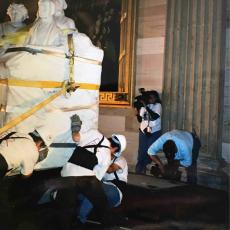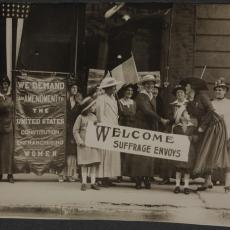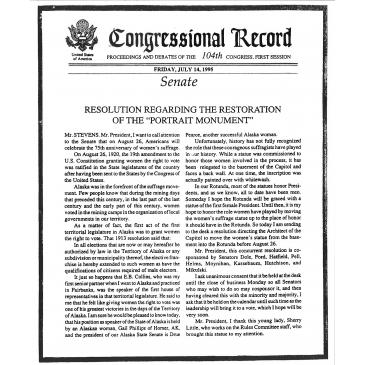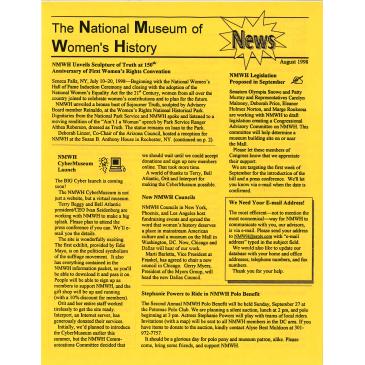
Our History
The National Women’s History Museum (NWHM) was founded in 1996 with a powerful vision: to ensure that women’s contributions to American history are visible, valued, and permanently recognized.
Our origin story begins with a symbol—and a question. In 1995, Museum founder Karen Staser stood in the U.S. Capitol Rotunda, gazing at the Portrait Monument (Adelaide Johnson, 1920), a marble sculpture honoring suffragists Elizabeth Cady Stanton, Susan B. Anthony, and Lucretia Mott. For decades, the statue stood largely hidden in the Capitol’s Crypt. In 1997, thanks to bipartisan advocacy led by Staser and a grassroots coalition of volunteers, the statue was moved into public view—a symbolic moment that inspired the founding of the Museum.
Since then, NWHM has grown into the nation’s leading organization dedicated to uncovering, elevating, and expanding access to women’s history. As a private, nonprofit, nonpartisan institution, we are independent from the Smithsonian Institution and other government-affiliated museums. This independence allows us to remain focused exclusively on our mission-driven work—developing inclusive exhibitions, leading innovative educational initiatives, and conducting original, data-informed research that brings women’s stories to the forefront. Our work is powered by private support, not federal funding, allowing us to remain agile and mission focused.
We believe women’s history education is foundational to achieving gender equity in the United States. When students and communities learn about women’s contributions, struggles, and triumphs—often achieved in the face of systemic barriers—they gain a deeper understanding of the structures that shape our society and the opportunities that lie ahead. These stories challenge stereotypes, expand the realm of possibility for young people, and reveal how societies flourish when everyone has a seat at the table. Women's history is not only a matter of inclusion; it's an investment in a more just, innovative, and collaborative future.
In 2014, NWHM helped fund, staff, and champion the creation of a bipartisan Congressional Commission to explore the feasibility of a national women’s history museum on the National Mall. The Commission’s findings confirmed what NWHM had long advocated: the American public strongly supports a dedicated women’s history museum. These efforts ultimately helped lead to the establishment of the Smithsonian American Women’s History Museum, authorized by Congress in 2020. While that institution continues the vital work of building a collection-based museum, NWHM carries forward its original mission as a digital-first organization, engaging millions each year through dynamic storytelling and accessible, community-centered programming.
Today, the Museum leads a unique, decentralized Museum-in-Residency model, partnering with cultural institutions across the country to co-create multi-year exhibitions and community-rooted programming. Our inaugural residency, We Who Believe in Freedom: Black Feminist DC, opened in 2023 at the Martin Luther King Jr. Memorial Library in Washington, D.C., illuminating the legacies of Black feminist activism in the nation’s capital. Our next major exhibition, Faith and Freedom: Women’s Social Justice Activism Through the Lens of Spirituality and Religion, will open in March 2026 at the Fulton County Public Library’s Central Library in Atlanta, Georgia. Each residency integrates site-specific engagement and educational programming designed to reflect local identities while contributing to a broader national conversation on women’s history.
For nearly 30 years, the National Women’s History Museum has illuminated the stories of women who have shaped our past—and who continue to shape our shared future. Women’s history is not a footnote. It’s foundational.
A Letter from our Founder

We have an exciting project to share with you. If our core of national volunteers is any indication, a tidal wave of interest in women's history is sweeping over America. In response, we have founded the National Women's History Museum in Washington, DC to preserve and celebrate the story of Woman.

It was April 1995 when I conceived the National Women's History Museum in a White Paper written to give voice to both the empowerment and dismay I felt after 13 years of self-directed research on women's history followed by the surprise of realizing that this history was largely missing from our nation's capital, including the Smithsonian Institution.
We sat on the Rotunda floor, ate pizza, and drank champagne.
Ann E. W. StoneCo-Founder and Member Emerita, National Women's History Museum

On Mother’s Day weekend two decades ago, a group of women dedicated themselves to moving Adelaide Johnson’s Portrait Monument to Lucretia Mott, Elizabeth Cady Stanton and Susan B. Anthony out of the U.S. Capitol’s basement, known as the Crypt, to its rightful place in the Capitol Rotunda.
Our Institution
Visitors are invited to explore the NWHM’s institutional archives from 1996 through 2018, including early NWHM history, organization, web content, newsletters, and brochures. The resource library is open between 9:00 am – 5:00 pm, Tuesday through Thursday. Please make an appointment to visit by emailing info@womenshistory.org.
Archives: Resolution Regarding the Restoration of the Portrait Monument
Archives: Here's the Rest of the Story

Women's contributions and accomplishments for the most part have been overlooked and consequently omitted from mainstream culture. The National Women's History Museum will help fill that void. Rather than rewriting current exhibitions at other history museums or having to decide what to omit elsewhere to "fit in" women's history, the Museum will serve to place women's history along side current historical exhibitions.
Women's history isn't meant to rewrite history. The objective is to promote scholarship and expand our knowledge of American history.



